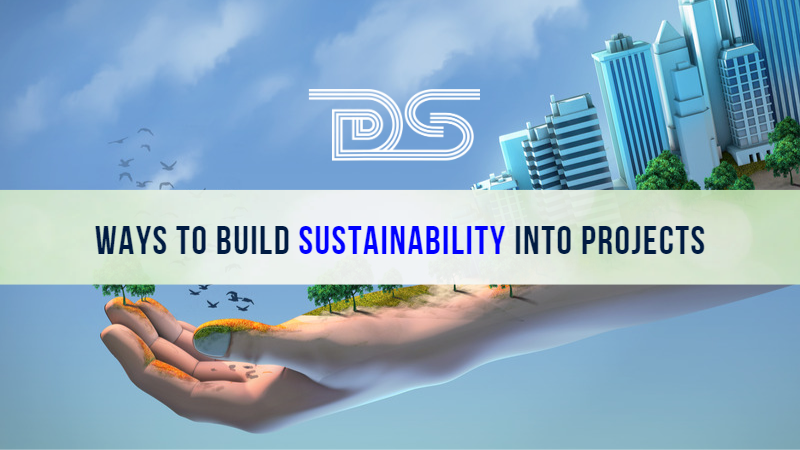
by Dharam CW2 | Nov 24, 2023 | General
The world is becoming more aware of the destructive impacts of climate change, and many businesses have started realizing the critical importance of sustainability to their future operations. Making the projects more sustainable is important to build a more sustainable world. But how to establish it?

Consumer Shift to Sustainability
According to Deloitte research, 28% of customers have stopped purchasing specific items owing to ethical or environmental concerns, increasing to 45% among Gen Z consumers. Approximately half of the consumers are prepared to spend extra money on more ethical and ecologically friendly brands.
However, keeping track of and being open about an organization’s sustainability initiatives is difficult if these metrics and methodologies are not evaluated and integrated into project processes. Unfortunately, what frequently happens is a lot of greenwashing, over-promising, and under-delivering sustainability goals, which may lead to even more distrust in brands and corporations.
As a result, many organizations are adding and integrating new sustainability features into their pre-existing project processes to meet the growing need for accountability and transparency in sustainability activities. However, as regulations evolve and customers grow more attentive, this strategy may no longer be adequate. That is why the organization needs sustainable project management.
Sustainable project management
71% of the world’s top 500 companies openly disclose their greenhouse gas emissions, among other energy metrics. Sustainability has become a commercial priority for all industries, and organizations recognize that it is not responsible for ignoring the problem.

Broadening Project Management for Sustainability
However, sustainable project management is more than just being green and combating climate change. It is a duty to ensure that resources are utilized appropriately, that individuals are treated equally and fairly, and that communities are considered when making choices. Therefore, project managers in this sector will adopt a comprehensive approach, evaluating environmental, social, and economic aspects. They collaborate with environmental planners, hydrogeologists, and geotechnical engineers, to name a few of the ecological professions helping to remake our planet for the better.

Principles of Sustainable Project Management
Sustainable project management is an approach that:
- Takes into account the complete Triple Bottom Line viewpoint.
- Considers the complete life cycle of a project, from project-related activities through final deliverables.
- Engages stakeholders actively and openly rather than merely managing their expectations.
- Accepts responsibility for its actions to society and the environment.
- Considers the short and long-term consequences of all project operations and results.
Building sustainability into projects
Project managers are responsible for supervising the project delivery and support procedures. They will both strive to ensure client satisfaction while inspiring their team to deliver excellence. That is the essence of the role of a project manager.
Meanwhile, a project manager concerned with sustainability will take a more comprehensive approach. They will consider resource use, climate change mitigation, property rights, community engagement, and human rights. It’s a complicated profession that, when done correctly, can have a huge influence on civilizations. The project manager’s objective is to produce value and complete a project on time and within budget, but also to do it ethically and fairly.
Environmental management and responsible resource use have never been more popular. As a result, companies worldwide are seeking methods to cut waste and lessen the environmental effect of their operations. Being environmentally responsible not only helps firms appeal to customers, but it may also assist save costs by reducing resource requirements and minimizing exposure to potential regulatory fines.
When a company implements a “green” mindset into its project management approach, the positive impacts may spread across the organization, resulting in increased efficiency, less waste, and increased employee morale. Here are some ideas for building and carrying out sustainable projects in any industry.

Strategies for Project Sustainability Across Industries
- Start by assessing your current project’s sustainability.
Before taking measures toward increased sustainability, you must first understand where you are now. A sustainability analysis can assist the project manager in identifying the most significant development areas and measuring success as the sustainability project takes shape. First, determine if the concept of sustainability applies to a project or project management technique, and then assess the costs and effort necessary to improve.
- Develop a sustainability strategy
Once the evaluation is complete, the next stage is to develop a strategy that describes the business’s goals for enhancing sustainability, like how the goals will be achieved and what the organization wants to gain from the process. Like a project plan, the strategy should identify the people, roles, or departments that will drive the sustainability effort and the degree of power they will have in establishing project priorities.
Every day, modern organizations face new and growing obstacles. On the other hand, sustainable businesses have proven to be more resilient. But where do you begin? What steps can be taken to take your efforts to the next level? Here are the four critical steps in developing a sustainability strategy.

Crafting a Sustainability Strategy in Four Steps
Step 1: Identify the impact factors
Before developing a sustainability strategy, you must determine which factors are important to your company. Each company is unique based on the following:
- The industry you operate in
- The size of your company
- The location
- Your place in the supply chain
Different aspects will be relevant to your business.
The four pillars of sustainability
To ensure that your sustainability strategy has the greatest potential impact, you must first determine which aspects are most important to you. Companies should undertake a materiality analysis to do this. Here are the four sustainability pillars to consider in the analysis:

Core Aspects of Sustainability
- Environment
- Labour and Human Rights
- Business Ethics
- Sustainable Sourcing
Collecting data
Starting a stakeholder engagement with internal and external stakeholders is an excellent strategy for discovering your impact factors. In addition, conducting a survey or interviews will give you more profound knowledge.
Step 2: Determine the long-term vision and mission
After recognizing the crucial material issues, determine which ones you can genuinely influence. It is now time to develop a long-term purpose and vision. These two steps are critical for good strategic planning. They may give consistency and establish limits for your business and its employees.
The ideal future
A mission statement focuses on your company’s present position and briefly explains its main purpose, focus, and goals. On the other hand, a vision statement summarizes an organization’s goals and the larger influence it hopes to have in the future. As a result, your vision and mission statement must represent your fundamental materials challenges and expand on your materiality assessment results. In addition, your company’s distinct traits must be taken into account. This aspect may assist you in prioritizing the impact elements and creating long-term alignment in your organization.
Step 3: Formulate the sustainability strategy
Finally, in the third step, you can begin designing the real strategy, which is a more immediate translation of your vision and goal. It should include all of the impact elements (identified in step 1) that are relevant to your business. More precisely, you must determine short- and mid-term objectives to realize your long-term vision and purpose (identified in step 2). Breaking down these long-term high-level statements will make each step more concrete and manageable.
Setting goals
The goals should be SMART:
- Specific
- Measurable
- Achievable
- Realistic
- Timely
After you’ve chosen a set of relevant targets, you’ll need to decide what steps your organization will take to reach them. Project outlines and processes must be outlined in detail. It is critical to ensure that your approach promotes both horizontal and vertical cohesion.
- The alignment of multiple departments and sustainability pillars is called horizontal coherence.
- Vertical alignment, on the other hand, refers to the consistency of choices made at the management (group or entity) and operational levels.
Step 4: Implement the sustainability strategy and track success.
The next stage will be to put your thoughts into action. Developing a great plan begins with collecting relative insights and understanding your primary material concerns. Then, by following a step-by-step approach, you can create a framework that will allow you to focus on investment and drive performance while also engaging internal and external stakeholders.
- Adopt a sustainability standard
As interest in project sustainability grows, companies have established guidelines to assist senior leaders and project managers in determining if they are reaching their sustainability objectives. For example, Green Project Management has issued the P5 Standard for Sustainability in Project Management, a set of goals and measurements that businesses may use to drive their efforts.
- Look for sustainability in partners and vendors.
The larger an organization, the greater leverage it has on the firms with whom it does business. So asking vendors and suppliers to raise their sustainability can lower the organization’s environmental footprint and lead to broader changes among the vendors and customers.
- Spread the word
Communication is the key to success in every organizational activity. Begin including your project teams in the process as soon as your sustainability strategy is determined. Solicit input on your sustainability goals and fresh suggestions from staff based on prior efforts. The more engaged your team is in the sustainability project, the more determined they will see it through.
- Be adaptable
One critical component of project sustainability is the capacity to adapt to changes in the organization, technology, and competition. Because these factors might shift a company’s goals while responding to them can help you succeed. This move might also include modifying project criteria or responding quickly to problems to execute projects on schedule and budget.
- Ensure projects are manageable
Projects become sustainable when they are manageable. While you may have larger ambitions, breaking them down into smaller, more manageable tasks might help you with expenses and resource allocation over time. You may also check your ability to implement manageable initiatives, such as having the necessary teams and approval processes. When planning for the future, be sure the organization can support any system or process modifications that a project manager wants to deploy.
- Review scalability
The ability to raise or reduce your resources based on your project’s demands is called scalability. This need frequently occurs when the scope of a project grows greater than intended, necessitating the use of additional tools, funds, people, or other resources to execute it. Ensuring that you can handle changes in scale may aid in developing a long-term sustainability strategy since it provides that the result will still be worth any additional demands.
Why should every project manager prioritize sustainability?
As governments worldwide establish net-zero carbon objectives, project managers are being charged with rethinking work processes to reduce emissions. Everything from planning to procurement to team structures is being re-evaluated to achieve sustainability goals. However, it is important to realize that sustainability covers more than climate change. It entails balancing projects’ environmental, social, economic, and administrative components to fulfill the requirements of present stakeholders without compromising the needs of future generations. Far from being a burden, sustainability provides an opportunity for project professionals to demonstrate their value by connecting with company strategic objectives centered on net zero. By incorporating sustainability into all aspects of their projects, project managers may make a significant difference and increase their visibility to the organization’s leadership.
Final Thoughts
Project Sustainability Management necessitates a more comprehensive strategy. It considers resource utilization, climate change mitigation, property rights, community engagement, and human rights. The project manager’s mission is to provide value and complete a project on time and under budget and do it ethically and fairly. The intertemporal character of sustainable project management contributes to its complexity. As a result, the lifetime of a sustainable project should not end after completion; environmental and social impacts must also be monitored and regulated afterward.
Project managers are in charge of managing the project delivery and support procedures. Both will ensure client satisfaction while inspiring their teams to produce greatness.
Project managers must consequently arm themselves with new indicators, such as ISO, SA, and others, for monitoring and managing these environmental and social issues. In the end, initiatives serve as a tool for effecting change, introducing new goods and services, and shaping society. As a result, sustainability should not be an afterthought but rather one of the primary aims of any project.
Feel free to check out my discussion on this topic with Thomas Walenta in YouTube
For any questions related to your Project Management career, training, and certifications, you can book an obligation free 15 minutes session with me by visiting https://bit.ly/2SbhTOK
You can subscribe to the vCare Project Management YouTube Channel to catch future videos of our Q&A series and certification success stories: https://bit.ly/2YF0wJl
You can subscribe to and follow my podcasts and interviews with Project Management Experts on YouTube at https://bit.ly/2NDY8wd
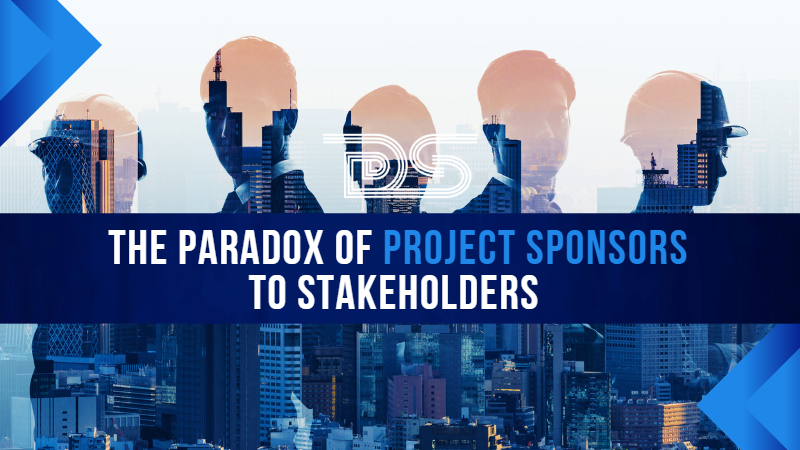
by DharamCW | Mar 10, 2023 | General
A project is deemed successful when it meets or exceeds the expectations of its stakeholders. Every project has a unique set of stakeholders—sometimes far too many. Trying to meet all of their requirements is more often an impossible task. Nonetheless, the project manager must deal with all stakeholder situations smoothly because the stakeholders and the people they represent often evaluate the project’s success.

Project Stakeholders
But who are the stakeholders? According to PMI, “Project stakeholders are individuals and organizations who are actively involved in the project, or whose interests may be positively or negatively affected as a result of project execution or successful project completion.”
Stakeholders can be internal or external to the organization that is carrying out the project.
“Project Sponsor” is also a stakeholder, typically an organization executive with authority to assign resources and enforce project decisions. Project sponsors are called internal stakeholders in the project. Stakeholders include the project manager, project team members, and managers from other departments within the organization. Identifying all project stakeholders as early as possible in a project is critical. Leaving out key stakeholders or the department’s function and not discovering the fault until the project is well underway could be disastrous.
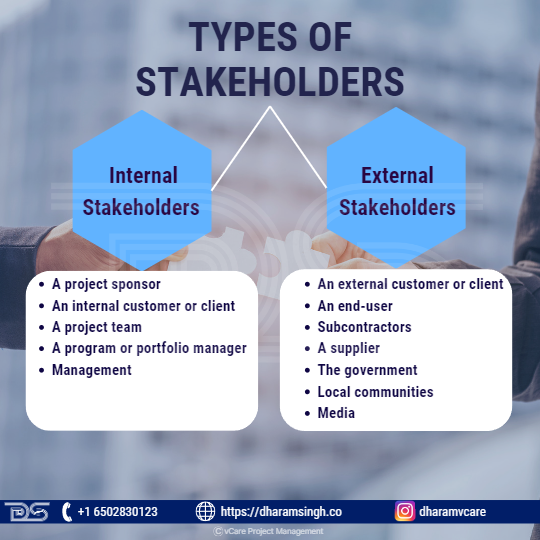
Types of Stakeholders
Types of Stakeholders
There are two types of project stakeholders:
- Internal Stakeholders
- External Stakeholders
Internal stakeholders are individuals or businesses whose relationship with a company is determined by their position within its structure. As the name implies, these individuals are involved in a project from the inside. They are as follows:
- A project sponsor
- An internal customer or client
- A project team
- A program or portfolio manager
- Management
- Another team’s manager of the company
External stakeholders are those interested in a company’s operations. Still, they do not necessarily have a role in the decisions of the business. However, they can influence success or failure based on their vested interests. They can be just as powerful as internal stakeholders. These stakeholders are not directly involved in the project but are affected by its outcome.
- An external customer or client
- An end-user
- Subcontractors
- A supplier
- The government
- Local communities
- Media
Characteristics of Stakeholders in a Project
- When contributing to a project, stakeholders have varying levels of responsibility and authority. This level may change as the project progresses. It can range from one-time contributions to complete project sponsorship.
- Some stakeholders may also actively or passively undermine the project’s success. These stakeholders require the project manager’s attention throughout the project’s life cycle.
- Stakeholder identification is a continuous process throughout the project’s life cycle. Identifying them, understanding their level of impact on a project, and meeting their demands, needs, and expectations are critical to the project’s success.
- Just as they can positively or negatively impact a project’s objectives, stakeholders can perceive a project to have positive or negative outcomes.
- A project manager’s most important role is managing stakeholder expectations, which can be challenging because stakeholders often have different or conflicting goals.
Stakeholder Management
Stakeholder management is the process of organizing, monitoring, and improving relationships with stakeholders. It entails systematically identifying stakeholders, analyzing their needs and expectations, and planning and carrying out various tasks to engage them. In addition, a good stakeholder management process will allow them to coordinate their interactions and evaluate the status and quality of their relationships with various stakeholders.
A critical component of running a successful project is developing and maintaining positive relationships with the affected communities and other stakeholders.
Investing time in identifying and prioritizing stakeholders, as well as assessing their interests, provides a solid foundation on which to build the stakeholder engagement strategy. In addition, good stakeholder management includes ‘business intelligence.
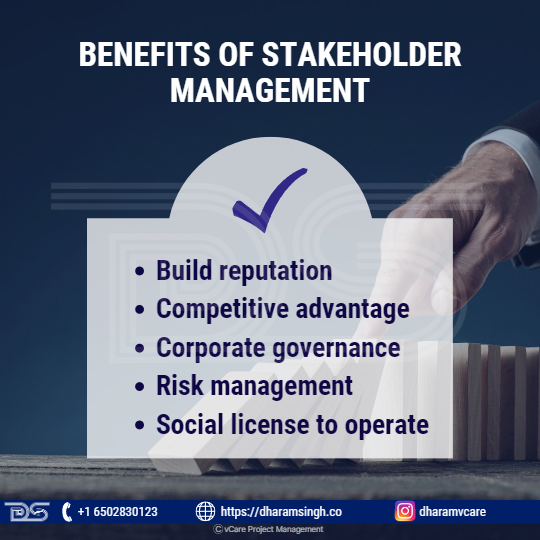
Benefits of Stakeholder Management
Benefits of Stakeholder Management
- Build Reputation
- Competitive advantage
- Corporate governance
- Risk management
- Social license to operate
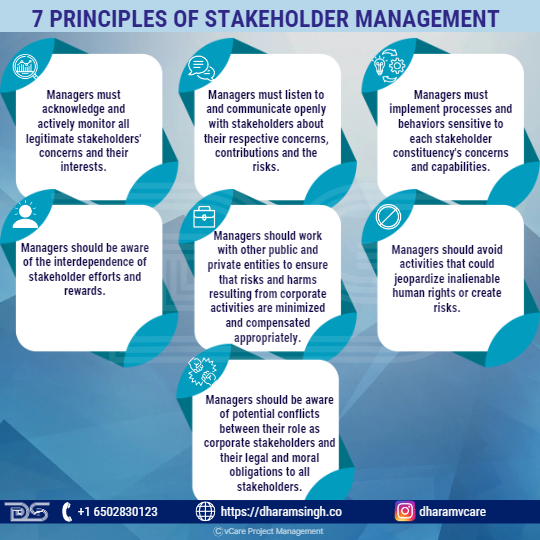
7 Principles of Stakeholder Management
7 Principles of Stakeholder Management
Clarkson Centre created the seven principles of Stakeholder Management for Business Ethics under the leadership of Max Clarkson. The Clarkson Principles are, in many ways, “meta-principles” that encourage management to embrace specific stakeholder principles and implement them according to the norms.
- Managers must acknowledge and actively monitor all legitimate stakeholders’ concerns and consider their interests in decision-making and operations.
- Managers must listen to and communicate openly with stakeholders about their respective concerns and contributions and the risks they face from their involvement with the corporation.
- Managers must implement processes and behaviors sensitive to each stakeholder constituency’s concerns and capabilities.
- Managers should be aware of the interdependence of stakeholder efforts and rewards and make an effort to fairly distribute the costs and benefits of corporate activity among them while taking into account their risks and vulnerabilities.
- Managers should work with other public and private entities to ensure that risks and harms resulting from corporate activities are minimized and compensated appropriately where they cannot be avoided.
- Managers should avoid activities that could jeopardize inalienable human rights or create risks that, if clearly understood, would be patently unacceptable to relevant stakeholders.
- Managers should be aware of potential conflicts between their role as corporate stakeholders and their legal and moral obligations to all stakeholders and address such conflicts through open communication, appropriate reporting and incentive systems, and, if necessary, third-party review.
Understanding the Stakeholders
A good understanding of the stakeholders is the key to successful stakeholder engagement. In addition, understanding stakeholder concerns and interests can lead to product or service ideas that address stakeholder needs while allowing the company to cut costs and maximize value.
1. What else can you learn about stakeholders to better understand their needs, priorities, preferences, and concerns? Consider:
- Demographic data- Ensure to engage with a diverse community and stakeholder groups.
- Social networks- Focus on the important, often undocumented, social connections between stakeholders.
2. Stakeholder Mapping – Stakeholder mapping is the visual process of depicting all stakeholders of a product, project, or idea on a single map. The main advantage of a stakeholder map is that it provides a visual representation of all the people who can have an impact on your project and how they are connected.
3. Salience model – investigate the power, urgency (need for immediate action), and legitimacy (appropriate stakeholders), as well as the interaction or groups of stakeholders that result.
4. Determine stakeholder expectations and compare them to the scope and expectations of the project or organization for which the engagement program is being run. Is there a mismatch in expectations, and how will this be addressed? Consider the following:
- What information do they need from you, how often, and in what format/channel do they want it?
- What is their financial/social/emotional stake in the outcome of the work? Is it favorable or unfavorable?
- What primary motivations will shape their perceptions of your project or organization and their interactions with you?
- What are their current feelings about the organization and project? Is it founded on reliable data?
- Who influences their thoughts, and who are they influenced by?
Ways to deal with common stakeholder problems and challenges
- Stakeholder conflict occurs when different stakeholders have incompatible goals. It causes a “problem” for the company because it can impact its performance and success.
- Conflict necessitates that businesses effectively manage stakeholder interests. Not all stakeholders are strategically important to the company. As a result, businesses must determine which ones should be prioritized.
- Potential problems can be avoided by conducting an upfront analysis of who the stakeholders are and how and when to involve them in the project.
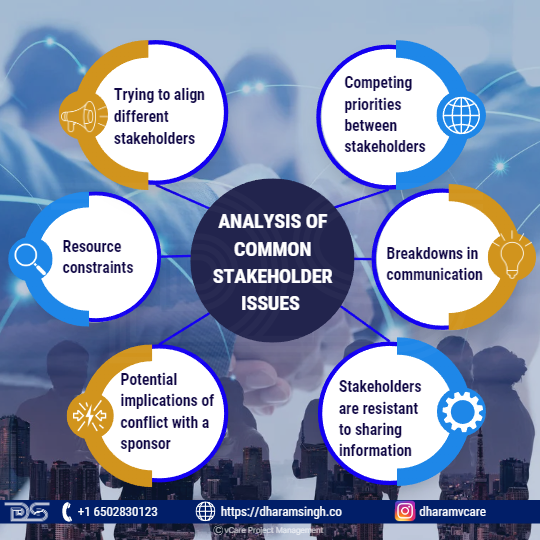
Analysis of common stakeholder issues
Analysis of common stakeholder issues
As no two stakeholders are the same, the issues they may introduce into a project will be vastly different. This factor means there could be many reasons why a project encounters stakeholder resistance or the project team struggles to gain traction. Identifying stakeholder issues during the project can help with planning ahead of time and preparing an appropriate response.
- Trying to align different stakeholders.
It is generally a good thing to have a variety of interests in the project and its outcome, but having a lot of different stakeholders can also pull the project team in too many different directions. In addition, it can be challenging for project managers to coordinate too many different stakeholders, which could add new difficulties to the project.
- Competing priorities between stakeholders
Stakeholders bring their objectives and expectations to the project. However, at least a few of these priorities frequently conflict with or compete with one another. In addition, priorities may vary depending on the department, the role, or the professional backgrounds of the individuals.
- Resource constraints
It’s possible that the team lacks some of the resources they require or that the project is utilizing resources that other stakeholders consider crucial to their projects. Resource competition is common in organizations and can lead to conflict.
- Breakdowns in communication
Effective communication between stakeholders and the project team is crucial for everyone to achieve their objectives and for the project to be successful. When there are communication breakdowns, the project may be delayed, or the team may not receive the necessary information. Without deliberate communication, stakeholders might unintentionally hinder the project’s success.
- Stakeholders are resistant to sharing information.
At times, important project sponsors are more focused on their success and fail to promptly or completely provide the stakeholders with the required information. As a result, stakeholders may attempt to disrupt a project unintentionally or on purpose.
- Potential implications of conflict with a sponsor
Conflict with project sponsors may have many consequences on the project management, such as these typical ones:
- The project’s progress is being slowed
- Reducing the effectiveness and timeliness of decision-making
- Putting team cohesion in jeopardy
- Undermining a project manager’s authority
- Fostering hostility and encouraging uncooperative behavior
- Creating a fearful environment for other stakeholders
- Obscuring the project’s vision
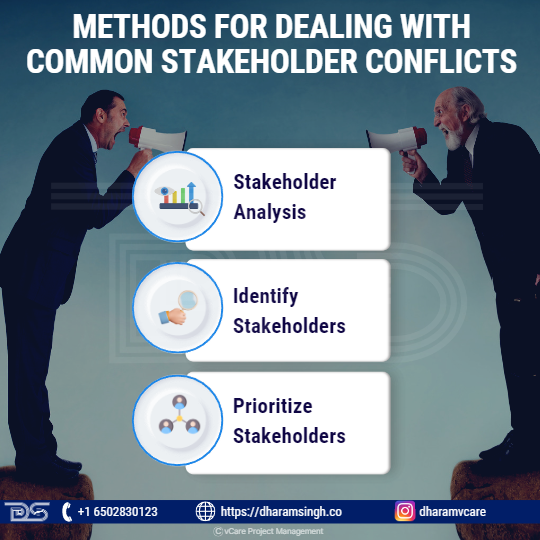
Methods for dealing with common stakeholder conflicts
Methods for dealing with common stakeholder conflicts
- Stakeholder analysis
Stakeholder analysis can offer insightful information and guidance, just as project managers must carefully examine resources and specifics. It can be helpful to respond appropriately by taking the time to consider how stakeholders affect the project’s progress.
By conducting a stakeholder analysis, one can learn how to control expectations, channel stakeholder influence toward project objectives, and deliver the information and updates that stakeholders expect from their team.
- Identify stakeholders
One must first identify the stakeholders to analyze them effectively. List every stakeholder that comes to mind, then include more individuals and organizations as necessary. As stakeholders, all parties involved in the project, those with authority over it or an interest in its success, should be listed.
- Prioritize stakeholders
The list of stakeholders can then be ranked according to impact, interest, and power. For instance:
- Key stakeholders: This first group heavily influences and controls the project. This group is frequently accurate for executive leadership at the company.
- Primary stakeholders: The project immediately affects the key stakeholders. This pack may include team members, departments, and internal or external clients who stand to gain from the project’s outcomes.
- Secondary stakeholders: The secondary stakeholders are those who play a supporting role, are indirectly impacted or have a less significant stake in the project.
Understand the key stakeholders
A few stakeholders are usually critical to the project. Key stakeholders invoke more power and may have a more significant stake in the project’s success than primary or secondary stakeholders. For example, key stakeholders could include their boss, company executives, or team leaders.
Finding the key stakeholders and understanding what they need can help keep the project on track because they may control important resources, have a significant impact on the project, or grant the necessary approval.
Create a communication plan
With a communication plan, project leaders will be better prepared to manage their stakeholders on the fly and keep the project moving forward.
- Create your communication strategy based on what the project leader knows about their stakeholders.
- Keeping track of what the stakeholders require from themselves allows project leaders to stay organized and focused on managing the project.
- Gaining the stakeholders’ trust is essential once the developed strategy has been implemented. Rather than dictating the project to them, make each stakeholder a priority – as appropriate – and give them space to contribute.
Final Thoughts
Different stakeholders in the project have different expectations. Project managers should look for potentially hazardous situations when those expectations might clash. Then, they must address and resolve the conflict or risk endangering the project and themselves.
Resolving stakeholder expectations conflicts is always linked to project success. Furthermore, using various forms of communication among the project team, such as senior management and stakeholders, increases the likelihood of mutual understanding. These techniques help project managers align stakeholder expectations and reduce the possibility of project distress.
Feel free to check out my discussion on this topic with Thomas Walenta in YouTube
For any questions related to your Project Management career, training, and certifications, you can book an obligation free 15 minutes session with me by visiting http://talktodharam.com/
You can subscribe to the vCare Project Management YouTube Channel to catch future videos of our Q&A series and certification success stories: https://bit.ly/2YF0wJl
You can subscribe to and follow my podcasts and interviews with Project Management Experts on YouTube at https://bit.ly/2NDY8wd
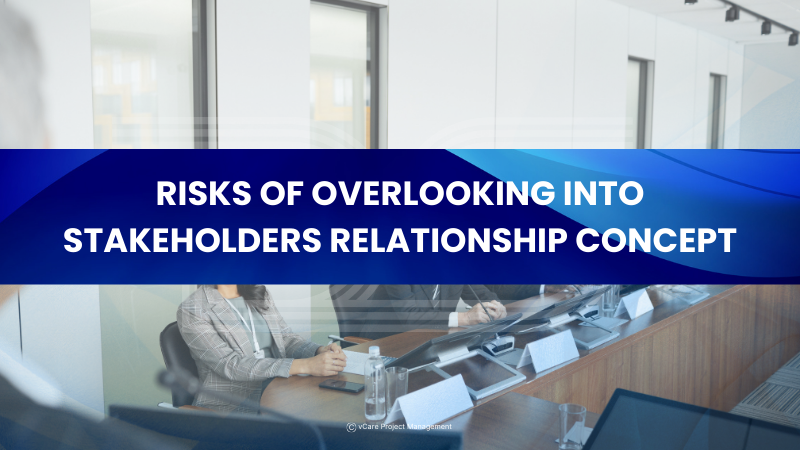
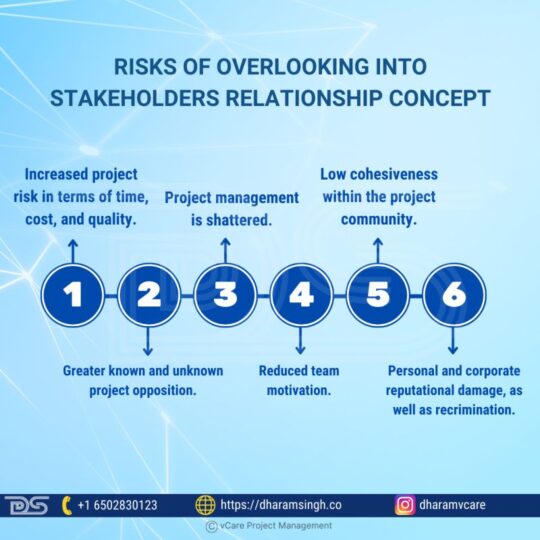


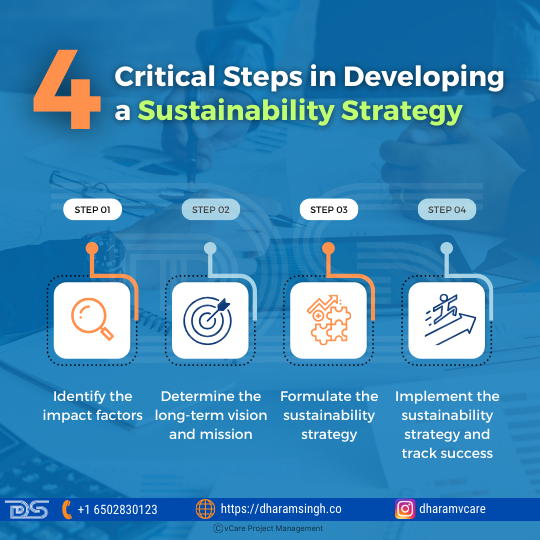
















Recent Comments